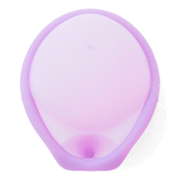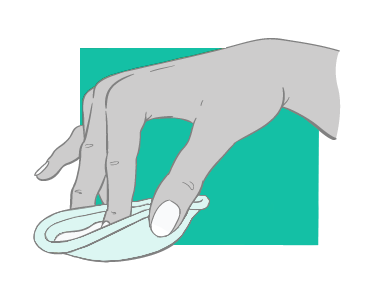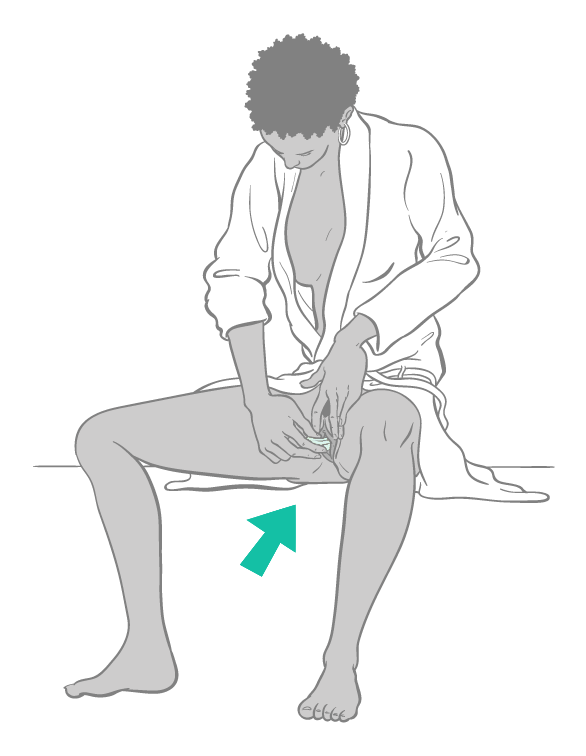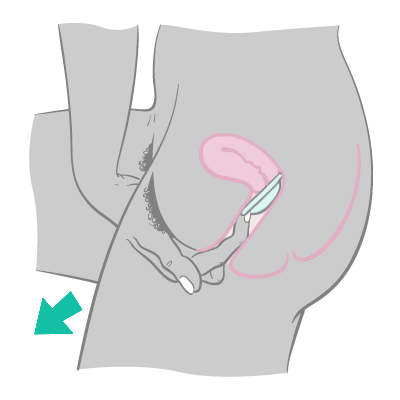- Birth control
- Diaphragm
Diaphragm

What is the diaphragm?
The diaphragm is a small, flexible cup made of silicone that you insert into your vagina, along with spermicide, before penis-in-vagina sex. The diaphragm covers your cervix, preventing sperm from entering your uterus and fertilizing an egg. The spermicide you use with it makes sperm less able to move.
The diaphragm is reusable for up to two years, no matter how many times you use it during those two years. There are two kinds of diaphragms, a one-size-fits-most version, called Caya, and a type with multiple sizes available that has to be fitted by a provider, called Milex. The Milex diaphragm is shaped like a little bowl, and the newer Caya diaphragm is shallower and slightly curved. Caya also has a smaller, inverted dome attached to make it easier to insert and take out.
One super important thing to know is that for a diaphragm to work correctly to prevent pregnancy, you need to use it with spermicide, which kills any sperm that make it past the rim of the diaphragm. You can use either over-the-counter spermicide or prescription-only spermicide (Phexxi).
Quick Facts
-
Effectiveness
The diaphragm (used with spermicide) is pretty effective the way most people use it.
Perfect use: 84% effective
Typical use: 83% effective
What are perfect use and typical use?
-
Hormones
The diaphragm is hormone-free.
-
Side effects
Irritation or urinary tract infections are possible.
-
Cost
Anywhere from $0 (with insurance) to $250, but you can keep using it for up to two years. Extra cost for spermicide of about $1 per dose.
-
STI protection
The diaphragm doesn’t protect against STIs.
-
Ongoing effort
You have to put it in place every time you’re going to have penis-in-vagina sex and leave it in for six hours after. You can leave it in for up to 24 hours, but you have to apply a new dose of spermicide before having sex each time.
The diaphragm might be right for you if...
Effectiveness at preventing pregnancy is NOT your top priority.
The diaphragm is not one of the most effective methods of birth control out there. But if the diaphragm is used perfectly (exactly how the instructions say to use it), with spermicide, every single time you have penis-in-vagina sex, it’s pretty effective at preventing pregnancy. With perfect use, diaphragms are 84% effective, which means that, on average, 16 out of every 100 people using a diaphragm perfectly for a year will get pregnant.
But most people have trouble using their diaphragm correctly from time to time. The effectiveness of the diaphragm with typical use, which means how real people use it in real life, is more relevant for most people than its effectiveness with perfect use. With typical use, the diaphragm is 83% effective at preventing pregnancy. That means that, on average, 17 out of every 100 people using a diaphragm for a year will get pregnant. (And of course, if you have sex without using your diaphragm at all, then it’s 0% effective at preventing pregnancy.)
You want birth control without hormones.
The diaphragm is a great option for people who don’t want to (or can’t) use hormones.
You’re willing to put in some effort before having sex, every single time.
In order for the diaphragm to work, you have to use it correctly, every time, no matter what.
You’re comfortable touching your body.
Using a diaphragm involves putting your fingers inside your vagina to insert and remove it. It’s a lot like putting in a menstrual cup or menstrual disc. If you’re comfortable doing that, you should be good to go.
You aren’t looking for STI protection, or you’re okay with combining the diaphragm with another method.
The diaphragm doesn’t offer any STI protection. So if that’s something you’re looking for, you can use condoms or internal condoms along with your diaphragm. Dental dams and/or gloves also offer STI protection, depending on what kind of sex you’re having. You may also want to consider PrEP (pre-exposure prophylaxis), which is a daily pill or an injection you can get every two months to decrease your risk of getting HIV.
You want a method that won’t affect your future fertility.
The only birth control method that permanently affects your future fertility is sterilization. The diaphragm does not affect your ability to get pregnant once you remove it from your vagina.
You don’t mind a method that requires talking to your health care provider.
You need a prescription to get either diaphragm, which means you’ll have to talk to a health care provider. If you are going to use the Milex diaphragm, you will have to see your provider in person. That’s because they will need to determine the right size for your body, which will involve a pelvic exam.
If you’re going to use Caya, your provider won’t need to figure out the right size for you because it only comes in one size. But if you want to make sure it fits you correctly, which is the key to it being effective, a provider can check that for you and also help you learn to put it in and take it out.
You want a method that you can stop without help from a provider.
Even though you do have to see a provider to start using the diaphragm, you don’t have to see one to stop using it. Because it’s a birth control method that you only use when you’re going to have sex, you are totally in control of stopping it.
You don’t need to hide your method.
The diaphragm isn’t one of the birth control methods that is easy to hide completely. First of all, you have to store your diaphragm in between uses, so someone you live with may be able to find it, depending on your circumstances.
Hiding it from a sexual partner is possible but may be difficult. Most partners can’t feel the diaphragm when it’s in. And because you can put your diaphragm in up to one hour before having sex, you may be able to avoid your partner knowing about it. But there are a few situations that would make it harder to hide from a sexual partner:
- If you want to have sex spontaneously, you will have to interrupt the action to put the diaphragm and spermicide in before penetration. And depending on what kind of spermicide you’re using, you may have to wait 10-15 minutes after inserting it for it to become effective.
- If you put the diaphragm in and then don’t have sex until one hour or more later, you will need to put more spermicide into your vagina (without taking the diaphragm out). That’s because most types of spermicide are only effective for one hour.
- If you want to have sex again while the diaphragm is still in, you will need to insert more spermicide into your vagina (without taking the diaphragm out) before each time you have sex.
You need a latex-free option.
Neither Milex nor Caya, the two kinds of diaphragms, contains latex, so they’re perfectly safe to use if you have a latex allergy.
You don’t have these risk factors.
The diaphragm isn’t recommended if:
- You’re having sex multiple times a day with different partners. There are a couple of reasons for this. The first is that you have to leave the diaphragm in for six hours after sex, but you can’t leave it in for more than 24 hours, which may be impossible depending on how many times you’re having sex in a day. The second is that spermicide can affect the cells in your vagina and cervix that help to fight off infections, and using spermicide multiple times a day puts you at higher risk of getting a sexually transmitted infection (STI).
- Using spermicide irritates your vagina or vulva.
- You have a history of frequent urinary tract infections (UTIs).
- It’s been less than six weeks since you’ve been pregnant, and your pregnancy lasted more than 14 weeks.
How do you use the diaphragm?
Inserting a diaphragm may seem difficult, but it just takes a bit of practice to get it right. If you’re using a Milex diaphragm, your provider will show you how to do it when you see them to get your prescription. If you’re using Caya, a visit to your provider is optional, but they can check the fit and help you learn how to put it in and take it out.
The diaphragm can be inserted just before sex, but it can also go in up to one hour before you have sex, which means it doesn’t have to interrupt the moment. (Just remember that if you’re still having sex or haven’t started having sex yet, and it has been more than an hour since you put in the diaphragm, you’ll need to put more spermicide into your vagina.)
But no matter when the diaphragm and spermicide go in, you have to leave the diaphragm in for at least six hours after the last time you have sex in order for it to work correctly. If you’re going to have sex again before taking it out (no matter how much time has passed since you last had sex, even if it’s only been a few minutes), leave the diaphragm in place and insert more spermicide way up in your vagina, following the applicator instructions that come with it. Just make sure not to leave your diaphragm in for more than 24 hours at a time, or use it during your period, because that can lead to toxic shock syndrome, a dangerous condition caused by an infection.
How to put in your diaphragm:

- Wash your hands well with soap and water.
- Check your diaphragm for holes and weak spots. You can check by filling it with water—if it leaks, that means it has a hole in it somewhere. If water can get through, sperm will be able to get through too, so use a different method of birth control, like condoms, until you can replace your diaphragm.
- Holding the diaphragm in your hand so it’s facing up, like a little bowl, add about a teaspoon of spermicide to the inside of the bowl. Spread a little spermicide around the rim as well. Any kind of spermicide will do, except for the film or suppository types. You can use over-the-counter spermicide or prescription-only spermicide (Phexxi). As with any kind of birth control, don’t forget to check the expiration date. It may not work if it’s expired.
- Get comfy, like you’re going to put in a tampon or menstrual cup. Some people like to put one leg up on the toilet seat cover, while others find that squatting gives them the best access.

- Put your index and middle fingers into your vagina and feel for your cervix, so you’ll know where to place the diaphragm. Your cervix will feel sort of hard but squishy, like the tip of your nose.
- Separate the lips of your vulva with one hand, and use the other hand to pinch the rim of the diaphragm and fold it in half.
- Put your pointer finger in the middle of the fold to get a good, firm grip. (Yes, you’ll be touching the spermicide.)

- Push the diaphragm as far up and back (towards your lower back) into your vagina as you can.
- Make sure your cervix is totally covered. You can check that the diaphragm is in the right place by making sure the front part of the rim is tucked behind your pubic bone. You should also be able to feel your cervix through the material of the diaphragm, so you can make sure the diaphragm is in place that way too.
- After sex, leave your diaphragm in for at least six hours before taking it out.
How to take it out:
- Wash your hands. (Or some people like to take their diaphragm out in the shower for easy cleanup.)
- Put your pointer finger inside your vagina and hook it over the top of the rim of the diaphragm or, if you’re using Caya, hook your pointer finger under the edge of the smaller removal dome.

- Pull the diaphragm down and out.
- After you take it out, wash it with mild soap and warm water. DON’T boil it, and never use powders or oil-based lubricants (like Vaseline or cold cream) on your diaphragm.
- Let it air dry.
- Pop it back in its case to use again next time you have sex.
Tips for making it work:
- You can use lube with your diaphragm, but only use the water-based kind.
- If you have sex again within six hours, insert more spermicide first—no matter how many times you have sex during the six-hour time period. Most types of spermicide will come with an applicator that allows you to insert it high up into your vagina, close to your cervix. That’s where you want it to be. The six-hour clock starts over again every time your partner ejaculates in your vagina or on your vulva.
- You can carry out your normal activities, including going swimming, going in a hot tub, and taking a bath, with your diaphragm in.
- If you have vigorous sex, check to make sure your diaphragm is still in place afterward. If it isn’t still in place, but your partner didn’t ejaculate, you can just add more spermicide and put your diaphragm back in. If your partner did ejaculate, and then you find that your diaphragm was out of place, using emergency contraception can help you prevent pregnancy.
- Don’t use the diaphragm when you have your period. It can lead to toxic shock syndrome.
- Don’t leave the diaphragm in for more than 24 hours.
How much does the diaphragm cost?
With insurance
If you have health insurance—whether it’s from work, school, your parents, or Medicaid— chances are good that you’ll be able to get this method without having to pay anything out of pocket.
Keep in mind that you need to use spermicide along with your diaphragm. Over-the-counter spermicide costs around $11 for 10 doses, and it will probably not be covered by insurance. If you use prescription-only spermicide (Phexxi), your chances are good that it will be covered by insurance, but if it’s not, or you don’t have insurance, Phexxi can cost up to $389 out of pocket for a box of 12 one-time use, pre-filled applicators.
Without insurance
If you don’t have insurance or if you’re on a plan that doesn’t cover birth control, diaphragms can cost anywhere from $85-250 out of pocket. If you need help paying to get the diaphragm, check with the sexual and reproductive health center(s) near you and find out if they offer free or low-cost birth control (most do).
What are the side effects and benefits of the diaphragm?
There are positive and negative things to say about each and every method. And everyone is different—so what you experience may not be the same as what your friend experiences.
The Positive
There are lots of things about birth control that are good for your body as well as your sex life. Here are some of the benefits of the diaphragm:
- You can put the diaphragm in up to an hour in advance of having sex.
- You can have sex as many times as you like while it’s in (you just have to apply more spermicide before each time).
- Neither you nor your partner should be able to feel it during sex.
- It doesn’t affect your hormones.
- You can use it while you’re breastfeeding.
The Negative
It’s normal to think about side effects, but for many people, they’re not a problem. However, some side effects may include:
- Vaginal irritation caused by the spermicide that you use with the diaphragm
- Frequent urinary tract infections
In addition to potential side effects, there may be some disadvantages to using the diaphragm:
- May interrupt sex
- Requires a prescription
- Offers no protection against STIs, and spermicides that are used with the diaphragm can cause irritation and increase the risk of getting an STI
- May require an in-person visit to your provider, depending on which diaphragm you get, if you give birth or your weight changes by more than 15 pounds
Where can you get the diaphragm?
You need a prescription from a health care provider to get the diaphragm, whether you’re using Caya or Milex.
You may be able to get the diaphragm directly from a health care provider, or get a prescription for Caya filled at most major drugstores, while Milex may have to be ordered from a medical supply store. You can also get Caya delivered to you by the manufacturer after having a telehealth visit.

We can help you find an in person provider or online birth control delivery service.
find health care